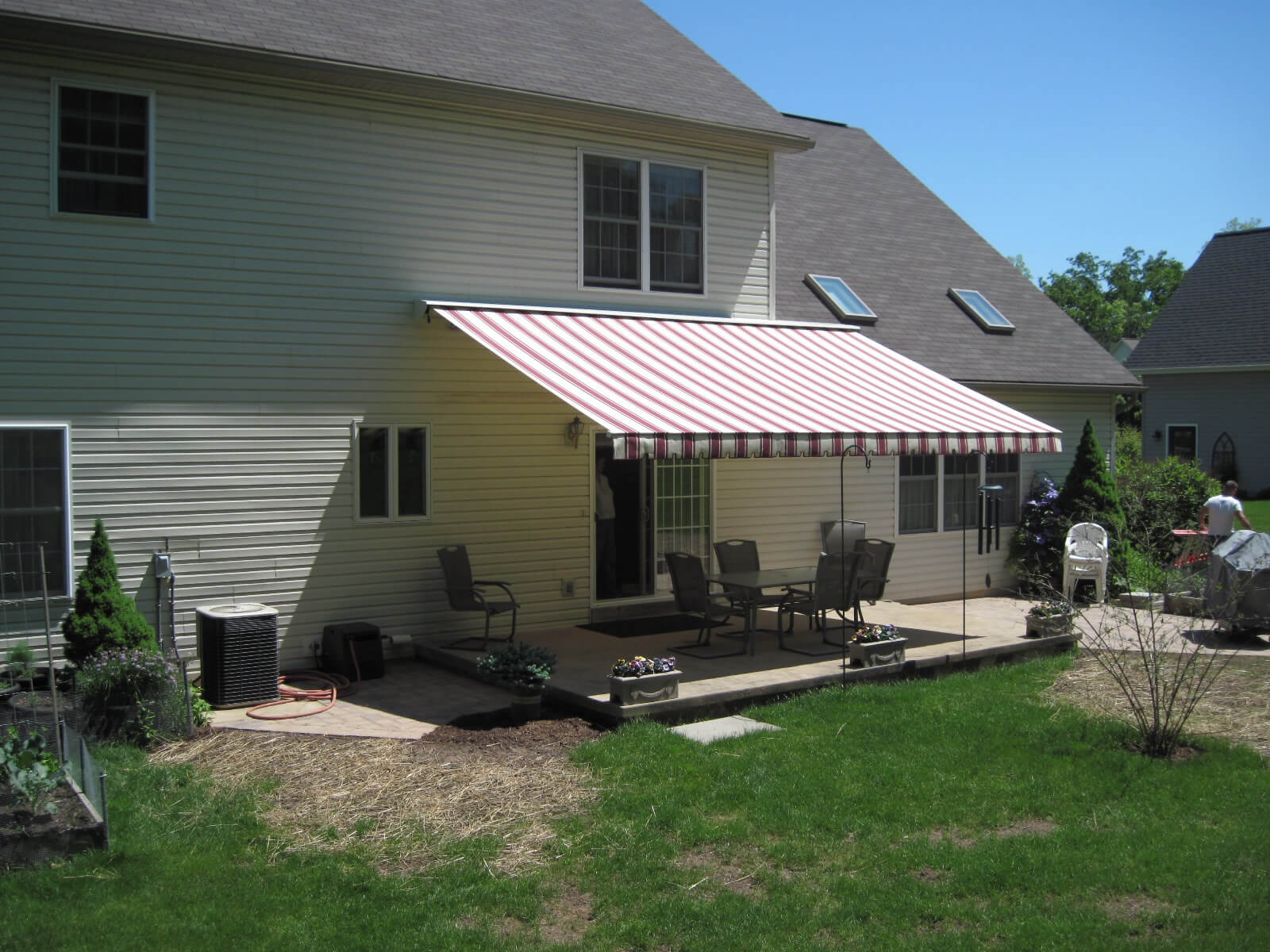The smart Trick of Door Awnings That Nobody is Talking About
To back up to bigger installments, tilted rafters connected the front cross bar to the building exterior. The upper end of the canvas was linked to the exterior with nails, with grommets as well as hooks, or by lacing the canvas to a headrod bolted to the facade. The other (forecasting) end of the canvas was curtained over, or laced to, a front bar with the side frequently suspending to create a valance.
On overcast days or when rainfall did not intimidate, the covering was often rolled up against the building exterior; during the winter season appropriate maintenance asked for the elimination as well as storage of awnings. Photographs from the mid-1800s typically reveal the bare framework, recommending that the covering was prolonged only when needed.
A strong, carefully woven cotton fabric utilized for centuries to make outdoors tents as well as sails, canvas is a functional product with a fairly short life expectancy compensated for by its affordable. During the 2nd half of the 19th century, iron pipes pipeline came to be a preferred material for taken care of awning structures. Right here, a pipe frame without its canvas cover extends around the corner of a structure in Washington, D.C.
Awnings came to be an usual attribute in the years after the Civil War. Iron pipes pipe, which was rapidly adapted for awning frames, became widely available as well as budget-friendly as an outcome of mid-century industrialization. It was a natural product for awning frameworks, quickly curved and threaded with each other to make a variety of various sizes and shapes.
Excitement About Aluminum Window Awnings
An awning industry developed supplying a range of framework and also textile choices adaptable to both storefronts and also windows. black awning. Operable Awnings In the 2nd fifty percent of the 19th century, manufactured operable awnings grew in appeal. Formerly, a lot of awnings had taken care of frames-the main means to retract the treatment was to roll it up the rafters by hand.
The arms were lowered to forecast the awning or elevated to retract the awning making use of simple rope and pulley-block setups (corrugated metal awning). Because the canvas remained connected to the framework, retracting awnings allowed a more flexible method to shading-shopkeepers and proprietors could incrementally readjust the amount of awning insurance coverage depending upon the climate condition.
In case of unexpected tornados, proprietors can promptly retract the awning versus the structure wall surface where it was protected from wind gusts. A 19th century footwear shop in Richmond, Virginia had an operable awning retracted against the structure exterior. Hinged expansion arms were raised and also lowered enabling for an awning setup quickly changed in action to weather.

Photo: Library of Congress, Prints as well as Photo Division, LC-USZ 62-99053. However the very early operable awnings had their very own downsides. When pulled back, the treatments on very early operable awnings bunched up versus the structure exterior where it was still partially revealed to severe climate. (Actually, degeneration was frequently increased as moisture merged in the fabric folds.) Likewise, the retracted material usually obscured a portion of the window or door opening and also unless it was folded thoroughly, presented an unkempt look.
Some Of Door Canopy
When completely retracted, just the valance was visible. The roller was generally bolted to a backboard established versus the structure and also safeguarded underneath a timber or galvanized metal hood. Sometimes it was installed in a recessed box built into the facade. A lengthy removable handle (called a "winding support"), or a gearbox and crankshaft affixed to the building, was used to transform the roller.
Rollers, particularly those on window awnings, frequently had a spring that helped retract the awning and maintained the canvas from drooping excessively. The roller bar on top of a fixed-arm awning is cranked to launch the textile. As the canvas opens up the vertical arms turn downward from their lower point.
When the awning is lowered, the bottom joints of the arms travels up the slide rod to boost headroom beneath the completely extended awning. Picture: NPS documents. Many 19th century roller awnings had taken care of arms that were comparable to those located on the earlier operable awnings. The arms pivoted flush to the building when the awning was retracted and, with the aid of gravity, straightened over the sidewalk when prolonged.

Shapes and Stripes An expanded selection of offered canvas colors, patterns, and frame forms also appeared throughout this duration. Some coverings were dyed a strong shade; tones of slate, tan, and eco-friendly were especially preferred. Others had painted stripes on the top surface area of the canvas. Awning firms developed a colorful vocabulary of awning red stripes that improved the ornamental schemes of buildings, as well as in some situations, served as a structure's primary ornamental function.
An Unbiased View of Aluminum Window Awnings
Photo: Library of Congress, Prints and also Photo Department, LC-D 4-62072. The wider selection of frame and also canvas alternatives urged the review of awnings just as a method to offer shelter from rain and also sun. House owners found that the brand-new generation of awnings could boost exterior paint plans and also increase the aesthetic allure of their homes.

They were a budget-friendly, fast as well as easy enhancement. They likewise verified to be a simple means of catching outdoors space. Property owners could make use of awning-covered verandas, verandas as well as patio areas at any moment of day; food store had the ability to convert walkways to outside display areas secured from sunshine as well as fast changes in the weather condition.
Awnings increasingly functioned as indications recognizing the proprietor's name, products available, or year of facility. It was a pattern that would finish over a century later on with awning setups in which shelter was second to promotion. Awnings in the 20th Century Scissor arm awnings have a pair of vertical, hinged arms on either side of the setting up sustaining the front bar.

Picture: NPS data. Awning development throughout the very early the twentieth century concentrated on enhancing operability. Variations in roller awnings attended to the need to provide a progressively tailored item that accomodated a vast array of storefront arrangements and styles. New folding-arm awnings appeared that operated either vertically or horizontally supplementing the fixed-arm awnings established in the last 19th century.
How Aluminum Awnings can Save You Time, Stress, and Money.
Operated by gravity the arms expanded outside drawing the covering off the roller. Like a fixed-arm awning, the pitch of a scissors-type awning varied depending upon whether it was totally or only partly prolonged. Somewhat various was the "lateral arm awning" a horizontally operating awning that functioned like a human joint with the spring activity in the arms pushing external towards the road, opening up the cover from the roller and maintaining tension.
To open up the awning, the roller is cranked and the arms prolong outward pulling the cover away from the roller. Operable awnings, whether dealt with arm, scissors arm, or side arm, swiftly got popularity as customers came to value the adaptability, concealed look, as well as much longer life expectancy implemented by roller systems.
When side arm awnings were set up across a broad storefront or veranda, producers suggested spacing the arms at roughly 8 foot periods. Image: NPS data. New Coverings Slower to change was the material used to cover awnings. Canvas duck stayed the common awning material throughout the initial fifty percent of the twentieth century.
commercial awnings door awnings custom awnings